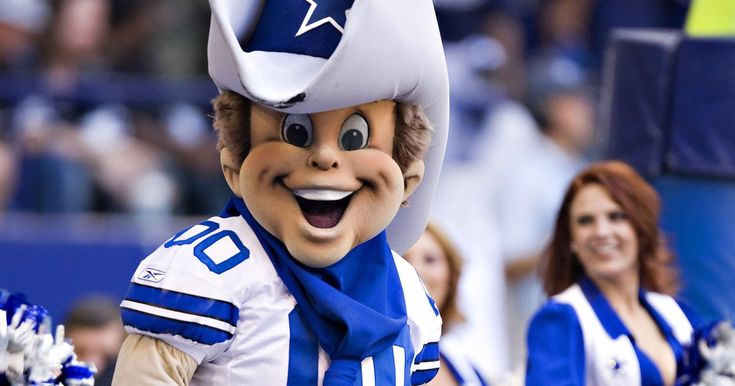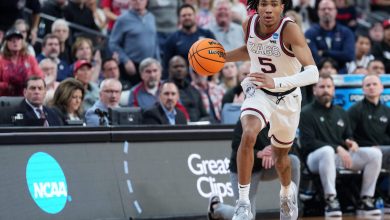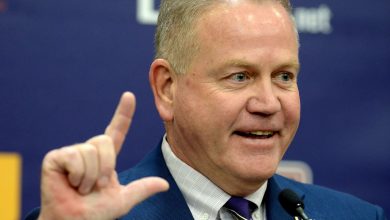“The Curse of Rowdy”: Since the debut of their mascot, the Cowboys have failed to win a Super Bowl.

“The Curse of Rowdy”: Since the Debut of Their Mascot, the Cowboys Have Failed to Win a Super Bowl
The Dallas Cowboys are one of the most storied franchises in the history of the National Football League (NFL), boasting five Super Bowl championships and an enduring legacy as “America’s Team.” Their brand is built upon a rich history of success, iconic players, and an iconic star logo that has represented excellence in football for decades. However, there is a bizarre anomaly that lingers over the team: the “Curse of Rowdy.” Since the debut of the Cowboys’ beloved mascot in the early 1990s, the team has been unable to secure another Super Bowl title. Could the arrival of Rowdy the mascot be a sign of misfortune, or is this merely coincidence? Let’s delve into this peculiar and often joked-about “curse” and explore the history of the Cowboys’ fortunes, the rise of Rowdy, and why it’s become a part of Dallas lore that fans can’t help but notice.
The Dallas Cowboys’ Championship Legacy Before Rowdy
Before the arrival of Rowdy, the Cowboys were already one of the NFL’s most dominant teams. Their success in the 1970s and 1980s set the stage for the franchise’s iconic status in American sports. Under the leadership of legendary head coach Tom Landry, the Cowboys won two Super Bowls (VI and XII) and became the first team to win back-to-back NFC championships in 1971-72. The “Doomsday Defense” and stars like Roger Staubach, Bob Lilly, and Chuck Howley became synonymous with the team’s success during this period.
The 1990s, however, marked the pinnacle of Cowboys’ dominance in the NFL. Under head coach Jimmy Johnson, the Cowboys assembled one of the most powerful and talented teams in NFL history. With a core of Hall of Fame-caliber players like Troy Aikman, Emmitt Smith, and Michael Irvin, Dallas won three Super Bowls in just four years (XXVII, XXVIII, and XXX). The Cowboys were once again positioned as an unstoppable force in the NFL.
It seemed the Cowboys had everything: legendary players, a Hall of Fame coach, and a fan base that spanned the entire globe. But even in the midst of this unparalleled success, an unexpected change was brewing — one that would later be remembered as a turning point in franchise history: the debut of Rowdy, the Cowboys’ official mascot.
The Birth of Rowdy: The Mascot’s Arrival in 1996
In 1996, the Cowboys introduced Rowdy, a larger-than-life cowboy mascot, to energize their fan base and promote the team’s brand. Rowdy, with his wide-brimmed hat, blue and white cowboy attire, and charismatic antics, quickly became a fan favorite. His presence at Cowboys games, events, and community engagements gave the team a fun and energetic personality that was designed to resonate with fans, especially children. He was the face of the Cowboys’ promotional campaigns, beloved for his performances, wild stunts, and unyielding energy.
Rowdy’s introduction came at a time when the Cowboys were still riding high on their dominant 1990s success, yet things began to take a shift almost immediately after his debut. At the time of Rowdy’s arrival, the Cowboys were the most successful franchise in football, having just won their third Super Bowl in four years. But once Rowdy stepped onto the scene, the Cowboys’ fortunes began to change in ways that no one could have predicted.
The Fall from Grace: A Super Bowl Drought Begins
The very season that Rowdy was introduced (1996) saw the Cowboys experience their first significant slip-up in years. After winning Super Bowl XXX in January 1996, the team failed to win another championship for nearly three decades. The following season, the Cowboys’ chances of defending their title ended prematurely in the NFC Divisional Playoffs. Their dominance that defined the early 90s began to fade, and they were eliminated from postseason contention year after year.
Rowdy’s debut marked a dramatic change in the franchise’s success, though it might be easy to chalk it up to coincidence. In fact, many fans began to notice a curious pattern: the Cowboys had not won a Super Bowl since Rowdy’s introduction. This phenomenon sparked the infamous notion of the “Curse of Rowdy.” While there was no logical reason to believe that Rowdy had anything to do with the team’s performance on the field, it became an ongoing joke and meme among Cowboys fans that every season since Rowdy’s arrival had been marked by failure to secure another championship.
The Curse: A Long Super Bowl Drought
From 1996 onward, the Cowboys entered what would become a prolonged period of underachievement. Although the team still boasted talented players and a winning culture, they could not recapture the magic of their dominant 1990s run. The Cowboys would not return to the NFC Championship Game until the 2000s, and they would go through multiple coaching changes, including the dismissals of Barry Switzer, Dave Campo, and Wade Phillips. Each of these eras produced decent teams, but nothing ever seemed to coalesce into a legitimate Super Bowl contender.
The team’s inability to even reach the NFC Championship Game was compounded by early playoff exits. During the 2000s, the Cowboys had a few flashes of brilliance, but they could never get past the first or second round. In 2007, the Cowboys finished the regular season with a 13-3 record, the best in the NFC. Yet, they were shocked by the New York Giants in the NFC Divisional Playoffs, with Tony Romo’s ill-fated fumble on a field goal attempt becoming one of the enduring symbols of the franchise’s playoff misfortune.
Despite an abundance of talent on both sides of the ball — including players like DeMarcus Ware, Jason Witten, and Terrell Owens — the Cowboys never seemed to be able to get it together when it mattered most. In 2014, they made a deep run into the playoffs, only to lose to the Green Bay Packers in the NFC Divisional Round in what many deemed one of the most controversial games in NFL history. The Cowboys’ inability to secure another Super Bowl title, despite having the talent to do so, further fueled the idea that something, or someone, was holding the team back.
Fans couldn’t help but joke that Rowdy, in all his enthusiasm and his seemingly innocent antics, might have cursed the team. With every failed playoff run and every season without a Super Bowl victory, the idea of the “Curse of Rowdy” seemed to gain more traction. Perhaps it was just a coincidence, or perhaps Rowdy’s high energy and mascot antics had become an ill-fated omen for the Cowboys’ championship chances.
The Changing of the Guard: Coaching Changes and Continued Frustration
In 2015, the Cowboys hired Jason Garrett as their permanent head coach, ending years of instability at the top. Garrett’s tenure, while often criticized for its lack of postseason success, saw the Cowboys begin to rebuild under a new identity. Dak Prescott, Ezekiel Elliott, and a solid offensive line emerged as the new foundation of the team in 2016, leading to a promising season in which the Cowboys finished 13-3. But once again, their playoff hopes were dashed in the Divisional Round, this time by the Green Bay Packers in a heart-wrenching loss.
While the team continued to build around Prescott and Elliott in the following years, playoff disappointment and a lack of Super Bowl titles continued to plague the franchise. Despite winning NFC East titles and making the playoffs in several seasons, the Cowboys were repeatedly knocked out early.
Is There Really a Curse?
In reality, there is no scientific or logical reason to attribute the Cowboys’ lack of success in the Super Bowl to their mascot, Rowdy. The team’s struggles in the years since his introduction are likely a combination of factors, including roster turnover, coaching changes, injuries, and bad luck. However, the enduring idea of the “Curse of Rowdy” has persisted largely because it provides a humorous and convenient explanation for the team’s inability to secure a Super Bowl win in the modern era.
While the Cowboys have always been a highly competitive team, they have also dealt with a number of unfortunate circumstances that have kept them from reaching the promised land. Poor coaching decisions, missed opportunities, and bad luck in close games have played a role in their postseason failures. The presence of Rowdy as a mascot is just one of the many variables, and while it is fun to joke about, it is more of a humorous anecdote than a real cause of the Cowboys’ struggles.
The Hope for the Future
Despite the so-called “Curse of Rowdy,” there is still hope for the future of the Dallas Cowboys. With Dak Prescott leading the offense and players like Micah Parsons anchoring the defense, the team has the talent to compete for championships in the years ahead. The addition of a new head coach or changes to the team’s offensive or defensive strategies could provide the spark needed to return the Cowboys to their former glory.
The story of the “Curse of Rowdy” may continue to be a fun part of Cowboys lore, but it doesn’t define the future of the franchise. Fans will continue to support their team with optimism, regardless of any mascot-related superstitions. And one day, perhaps, Rowdy’s antics will coincide with the Cowboys’ return to the Super Bowl, ending the decades-long drought with a happy, and ironically fitting, conclusion to the saga.









